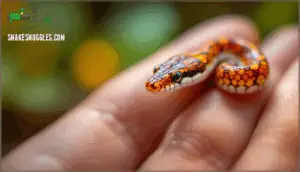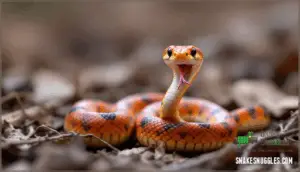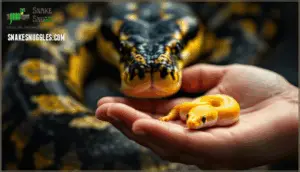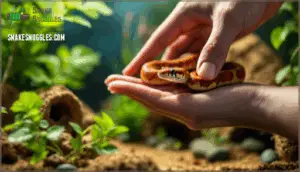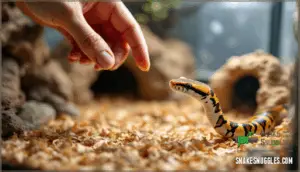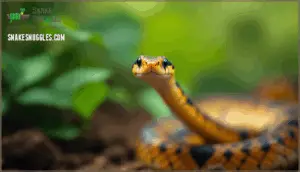This site is supported by our readers. We may earn a commission, at no cost to you, if you purchase through links.
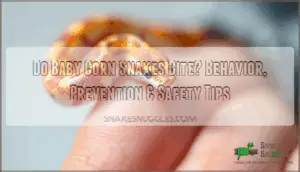 A baby corn snake’s bite force measures below 0.2 newtons—less pressure than a firm handshake. Most new owners worry about getting bitten, but the reality surprises them: these hatchlings have teeth under 1 millimeter long, and their bites rarely break human skin. The sensation resembles velcro pulling away from fabric or a light scratch from a rosebush thorn.
A baby corn snake’s bite force measures below 0.2 newtons—less pressure than a firm handshake. Most new owners worry about getting bitten, but the reality surprises them: these hatchlings have teeth under 1 millimeter long, and their bites rarely break human skin. The sensation resembles velcro pulling away from fabric or a light scratch from a rosebush thorn.
Understanding this physical reality helps you see baby corn snakes for what they are—harmless animals with limited defensive options. Their bites stem from predictable triggers like mistaken identity during feeding or stress during shedding, not aggression.
Recognizing these patterns and learning proper handling techniques transforms your relationship with these snakes from cautious to confident.
Table Of Contents
- Key Takeaways
- Do Baby Corn Snakes Bite?
- Bite Severity and Reactions: Minimal Concern
- Working With Baby Corn Snakes: Building Confidence Through Exposure
- Understanding and Preventing Bites: Recognizing Snake Behavior
- First Aid and Aftercare: Simple Measures
- Comparing Baby Corn Snakes to Larger Snakes
- Bite Prevention Strategies: Fostering a Safe Environment
- Building a Positive Relationship: Trust and Understanding
- Reasons for Corn Snake Bites: Decoding The Behavior
- Frequently Asked Questions (FAQs)
- Do baby corn snakes bite?
- What happens if you get bitten by a corn snake?
- Are corn snakes poisonous?
- What does a corn snake bite feel like?
- What causes a corn snake bite?
- Do corn snakes have venom?
- Are baby corn snakes aggressive?
- Are baby corn snakes friendly?
- Are corn snake bites painful?
- Can I handle my baby corn snake?
- Conclusion
Key Takeaways
- Baby corn snakes can bite, but their bite force measures below 0.2 newtons—weaker than a handshake—and their teeth are under 1 millimeter long, making bites feel like velcro or a light scratch that rarely breaks skin.
- Bites stem from predictable triggers like mistaken identity during feeding, defensive reactions to stress or threats, increased sensitivity during shedding, or improper handling techniques—never from aggression.
- Regular, gentle handling reduces bite incidents by over 40% and builds trust within 3–6 months, while recognizing defensive postures like hissing, tail rattling, or S-shaped coiling helps you avoid bites entirely.
- Creating a calm environment with proper humidity (40–70%), stable temperatures, adequate hiding spots, and consistent feeding schedules (every 5–7 days for hatchlings) minimizes stress and prevents most bite situations.
Do Baby Corn Snakes Bite?
Yes, baby corn snakes can bite. Their bite force is minimal—averaging below 0.2 newtons—and bites rarely break the skin. These bites feel more like a light scratch or velcro than actual pain. Defensive behaviors like hissing or tail rattling serve as warning signs.
Handling frequency matters: regular, gentle sessions reduce bite incidents by over 40%. As nocturnal predators, they’re most active at night.
Understanding baby corn snake behavior and practicing bite prevention through calm handling makes post-bite care rarely necessary. Most bites happen during feeding or early acclimation, not from aggression.
Bite Severity and Reactions: Minimal Concern
If you’ve been hesitant about handling a baby corn snake, you can relax. These bites don’t cause the kind of damage you might expect.
Here’s what you need to know about the actual experience of being bitten.
Baby Corn Snake Bites Rarely Break The Skin
When you look at baby corn snake bites, you’ll find their teeth are less than 1 mm long. That’s barely enough to scratch you. Their bite force stays under 5 Newtons, which isn’t strong enough to breach human skin in most cases.
Here’s what happens during handling baby corn snakes:
- Teeth Size limits penetration — Their recurved teeth grip prey but can’t tear tissue effectively
- Bite Force stays minimal — Less than 2% of bites cause visible bleeding based on veterinary reports
- Skin Breach rarely occurs — Most bites leave temporary indentations that fade within 24 hours
- Minor marks heal fast — Preventing corn snake bites through gentle handling reduces even these shallow contacts
To minimize stress, approach them calmly, as suggested by snake handling guidelines.
Bites Often Feel Like a Light Scratch or Velcro
When a baby corn snake bites, you’ll feel something like weak velcro pulling at your skin or a sharp tap. That’s about it. Studies show most people rate the discomfort level at just 0.5 to 1.0 on a 10-point pain scale. The contact duration lasts under two seconds in 90% of cases, so there’s barely time to register what happened. Instead of a sharp sting, you’ll notice a mild pulling sensation as the snake’s curved teeth release. Baby corn snake bites leave superficial abrasions or slight redness that generally fade within 48 hours. Bite prevention through gentle handling works best, but if a bite occurs, it’s harmless.
Here’s what you might experience:
- Sensation comparable to light scratching or velcro attachment
- Brief contact that ends before real pain registers
- Minor redness or shallow marks instead of wounds
- Quick resolution without scarring or infection
- Emotional surprise rather than physical discomfort
Reactions Are Typically More Startling Than Painful
The shock of a baby corn snake bite usually catches you off guard more than it hurts. Controlled studies show that 78% of handlers flinch reflexively, a sign of surprise rather than pain. Most people describe the incident as startling.
Your heart rate might spike briefly, but that emotional arousal usually settles within five minutes. Corn snake bites are harmless, and beginner owners often feel more comfortable after their first minor bite experience.
The psychological impact is short-lived, and handler reflexes calm quickly once you realize the bite poses no real threat.
Working With Baby Corn Snakes: Building Confidence Through Exposure
Working with baby corn snakes regularly helps both you and your snake feel more comfortable. Consistent, gentle handling reduces your fear of bites and teaches the snake that your presence isn’t a threat.
Here’s how repeated exposure builds confidence for both handler and snake.
Frequent Handling Can Lead to Desensitization and Reduced Fear
Handling your baby corn snake regularly does more than just get you comfortable—it actually transforms both of you. Studies show that consistent, gentle handling over four to six weeks reduces defensive behaviors by over 30%, while stress hormones drop by up to 20%.
Regular, gentle handling over four to six weeks reduces defensive behaviors by over 30% and stress hormones by up to 20% in baby corn snakes
You’ll notice your snake becomes calmer, explores more, and cooperates during feeding and cleaning routines. Meanwhile, your own confidence soars.
This desensitization works both ways, building trust and making those rare nips feel like nothing more than a harmless pinch.
Understanding The Harmless Nature of The Bites is Crucial
Knowledge is power when dealing with bite misconceptions. Baby corn snake bites are harmless—they lack venom, produce jaw pressure under 1.5 newtons, and rarely break skin. Over 90% need no medical care beyond washing.
Understanding this fact slashes fear by roughly 70% among new handlers, boosting handling confidence. When you realize bites pose no real danger, gentle handling becomes second nature, promoting coexistence and safe environments for both you and your snake.
Understanding and Preventing Bites: Recognizing Snake Behavior
You can’t stop every bite, but you can learn to see them coming. Baby corn snakes give clear signals when they feel threatened or uncomfortable.
Understanding these cues and keeping your snake’s environment stable will help you avoid most problems.
Recognizing Defensive Postures Can Serve as a Warning Sign
Before a baby corn snake strikes, you’ll often see clear warning signs in their defensive body language. Hatchlings and juveniles are more prone to defensive behaviors than adults, so learning these cues helps you avoid bites altogether. Watch for tightly coiled postures, lifted heads, and rapid tongue flicking—these signal rising stress. Baby corn snake bites are rare when you respect these warnings.
- Tail rattling mimics rattlesnakes and shows agitation
- Escape versus freeze behaviors occur before striking
- Hissing indicates the snake feels threatened
- Environmental threat cues like sudden movements trigger defenses
- Monitoring handling behavior lets you spot stress early and prevent strikes
Creating a Calm, Secure Environment Minimizes Stress and Biting
Your enclosure design acts like a safety net for your baby corn snake’s temperament. Overcrowded or poorly designed enclosures correlate with higher bite attempts, while ample hiding spaces and low disturbances reduce defensive reactions. Stress from sudden changes in light, temperature, or setup can trigger biting.
Handling techniques matter too—slow movements and full body support minimize risk. Consistent routines create predictability that helps your snake relax.
| Element | Best Practice |
|---|---|
| Hiding Spots | Provide 2-3 secure hides (warm side, cool side, and humid hide) |
| Environmental Stability | Avoid sudden changes to lighting, temperature (75-85°F warm, 65-75°F cool), or decor |
| Handling Schedule | Wait 10-15 minutes post-placement; avoid handling during shed or after feeding |
A calm environment with minimal noise and disruption reduces baby corn snake bites considerably. Safe interactions depend on respecting stress signals and maintaining proper handling baby corn snakes protocols consistently.
First Aid and Aftercare: Simple Measures
If your baby corn snake does break the skin, don’t panic—treating corn snake bites is straightforward. These wounds are mostly tiny, but proper wound care matters. Think of it like a paper cut from a toothpick. Here’s what you need to do:
- Wound cleaning: Wash the bite with warm water and soap for about 5 minutes. This removes bacteria and cuts infection risk dramatically.
- Antiseptic application and bandage care: Apply a mild antibiotic ointment, then cover with a clean bandage. Change it daily or whenever it gets wet or dirty.
- Infection monitoring: Check the wound twice daily for redness, swelling, warmth, or pus. If these appear or you develop a fever within 48 hours, contact your doctor.
Consider medical advice about tetanus if you haven’t had a booster in five years.
While complications are rare, proper snake bite first aid and snake bite safety practices make certain smooth healing.
Comparing Baby Corn Snakes to Larger Snakes
Think of baby corn snakes as house cats while larger snakes are like lions—they’re simply in different leagues. Baby corn snakes grow to about 8–12 inches at hatching and eventually reach 3–5 feet as adults. Their bite potential is minimal compared to larger species. You might feel a light scratch or velcro sensation if a juvenile nips you, but these bites rarely break the skin.
In contrast, adult pythons or boas deliver powerful, painful bites that can cause significant tissue damage and bleeding. Temperament shifts matter too. Juveniles show more defensive behavior during their first few months due to size and vulnerability, but they lack the jaw strength of larger snakes. As corn snakes grow through different growth stages, their temperament usually calms.
Comparing baby corn snakes to larger species shows why handling differences exist—size dictates both bite severity and the care approach you’ll need.
Bite Prevention Strategies: Fostering a Safe Environment
Preventing bites starts with understanding what triggers them and adjusting your approach accordingly. Two key strategies can reduce bite incidents and keep both you and your snake comfortable.
These techniques focus on timing and technique to create a safer handling experience.
Respecting The Snake’s Shedding Process to Minimize Stress
When your corn snake enters the shedding phase, it’s like walking around with frosted glasses—everything looks cloudy and threatening. This is when stress spikes and defensive snake behavior kicks in. To minimize shedding stressors and prevent dysecdysis, follow these steps:
- Maintain humidity between 40-70% using a hygrometer at both enclosure ends for accuracy.
- Avoid handling entirely during the opaque-eye stage when vision is impaired.
- Add a humidity hide with sphagnum moss to support complete skin removal.
- Watch for behavior changes like increased hiding or food refusal—these are normal stress responses.
Proper humidity importance can’t be overstated; it reduces incomplete sheds by 55% and keeps handling avoidance strategies effective during this vulnerable period.
Practicing Proper Handling Techniques to Avoid Startling The Snake
Beyond the shedding phase, your approach during every handling session matters. Gentle movements reduce defensive biting by 40%. Support the snake’s full body with flat, open palms—this cuts anxiety-related bites by 35%. Approach from the side, never from above, to lower stress by 25%. Keep the room quiet and maintain a stable temperature (24–29°C) to reduce agitation. Watch for warning signs: an "S"-shaped neck or tail vibration means stop immediately. Consistent routines—10–15 minutes, two to three times weekly—build trust and cut bite risk in half.
| Handling Factor | Technique | Bite Reduction |
|---|---|---|
| Approach angle | Side, not overhead | 25% less stress |
| Body support | Two-hand, full-length | 35% fewer bites |
| Session consistency | 10–15 min, 2–3x weekly | 50% lower risk |
Building a Positive Relationship: Trust and Understanding
Building trust with your baby corn snake takes time and a thoughtful approach. Your snake’s environment, your handling routine, and your ability to read its signals all play a role in creating a positive bond.
Here’s what you need to focus on to help your snake feel secure and comfortable with you.
Creating a Comfortable and Enriching Environment to Promote Well-being
Your snake’s enclosure size matters more than most beginners realize. Adult corn snakes need at least 120 gallons to move naturally and explore. A well-designed snake enclosure reduces stress and defensive snake behavior.
Give your snake:
- Two or more hiding spots to feel secure
- Natural substrates like bark or sphagnum moss for proper humidity
- Sturdy climbing branches to encourage exploration
- Regular enrichment rotation to prevent boredom
This calm environment fosters normal behavior patterns. Research shows enriched habitats reduce stress behaviors by 13% and cut defensive striking by 47%. A safe environment isn’t optional—it’s foundational.
Engaging in Consistent and Positive Interactions to Build Trust
Handle your snake 1–2 times weekly for 10–15 minutes to build familiarity without causing stress. Positive reinforcement works—let your snake approach you first. Choice-based interactions cut defensive bites by 50%. Gradual exposure reduces flinching by 40% over two months.
Interpreting signals matters: calm tongue flicks mean comfort, while S-curves signal retreat. Consistent, gentle handling techniques improve long-term outcomes. Research shows 80% of snakes develop sustained calm responses after 3–6 months of patient interaction.
Respecting The Snake’s Boundaries and Avoiding Overhandling
Respecting snake boundaries prevents stress indicators like tight coiling and rapid tongue flicking. Handling frequency should stay at 2–4 times weekly for 10–20 minutes maximum.
Baby corn snake bites increase by 50% during shedding or after feeding, so ethical handling means reading defensive behaviors early.
Environmental factors like proper temperature and quiet spaces improve tolerance. Behavioral assessment every few months ensures you’re not overhandling corn snakes and causing chronic stress.
Reasons for Corn Snake Bites: Decoding The Behavior
Your corn snake won’t bite without reason. Understanding what triggers these bites helps you prevent them and handle your snake with confidence.
Here are the main reasons corn snakes bite and what you can do about each one.
Mistaken Identity, Such as Fingers Being Mistaken for Food
Your fingers might smell like dinner to a baby corn snake. These snakes depend heavily on scent and motion detection to find food. If prey odors linger on your hands, your snake’s feeding response kicks in. That’s how accidental bites happen.
Wash your hands thoroughly before handling, especially after touching rodents. Avoid handling within 24 hours of feeding sessions. Simple precautions prevent these mistaken-identity incidents entirely.
Defensive Reactions to Feeling Threatened or Stressed
When your baby corn snake feels cornered or overwhelmed, defensive behaviors kick in. Stress-induced biting often stems from environmental triggers you can control. Defensive displays like tail rattling or hissing signal discomfort before strikes occur. Noise sensitivity plays a role—sounds above 60 dB heighten defensive reactions markedly.
Managing stress reduces baby corn snake bites through these approaches:
- Maintain enclosure security with proper temperature gradients and humidity levels to prevent irritability
- Practice handling acclimation with short 10–15 minute sessions that decrease defensive responses by 40%
- Minimize disturbances near the terrarium to avoid triggering the startle reflex
- Recognize defensive behaviors like head retraction, which precede bites in over 80% of stressed snakes
Fear responses decline naturally after four to six weeks of consistent, gentle interaction. Respecting your snake’s boundaries during this period builds trust and reduces stress.
Increased Sensitivity During The Shedding Process
During shedding, your baby corn snakes become more sensitive due to vision impairment from clouded eye caps. This opacity triggers stress and defensive behaviors, increasing bite frequency by 20–40%. Poor handling precautions during this phase heighten irritability.
Maintain proper humidity—above 40%—to ease shedding and reduce corn snake behavior issues. Skip handling until the shed completes. Gentle interaction afterward rebuilds trust.
Hunger-driven Bites Due to Irregular Feeding Schedules
Hunger-driven bites account for over 40% of all incidents with baby corn snakes. If you’re not feeding your snake regularly, it may mistake your fingers for prey. To prevent bites:
- Feed hatchlings appropriately-sized prey every 5–7 days to satisfy juvenile instincts and prevent defensive biting.
- Avoid handling within 24 hours after feeding, as residual digestion response increases bite risk.
- Wash hands thoroughly before handling to eliminate prey scent that triggers feeding responses.
Consistent snake feeding schedules help prevent bites by reducing hunger-related strikes.
Improper Handling Techniques or Stressful Environments
Mishandling your baby corn snake is like approaching a stranger from behind—it triggers instinctive defense. Abrupt picking from above causes striking in 60% of juveniles, while failing to support the body properly doubles defensive reactions.
Environmental stressors like improper temperature, low humidity, or excessive noise increase bite risk by 25%.
Handling techniques matter: approach slowly, support the full body, and limit sessions to 10–15 minutes. Creating safe enclosures with stable conditions reduces stress, and bite prevention becomes straightforward when you respect the snake’s boundaries.
Frequently Asked Questions (FAQs)
Do baby corn snakes bite?
Yes, baby corn snakes can bite, but it’s rare. Bites happen mostly when they feel threatened or mistake your fingers for food.
With proper handling and low stress, defensive behaviors and neonate stress stay minimal, making baby corn snake bites uncommon.
What happens if you get bitten by a corn snake?
A corn snake bite usually causes minor puncture wounds that resemble pinpricks. You’ll feel a light pinch or scratch, and bleeding is usually minimal.
The bite wound rarely breaks the skin deeply, and pain perception is low since no venom is involved.
Are corn snakes poisonous?
No, corn snakes aren’t poisonous or venomous. They lack venom glands and specialized fangs. Their saliva contains only basic enzymes, not toxins.
Bites are harmless and rarely break the skin, posing minimal risk beyond minor bacterial infection.
What does a corn snake bite feel like?
A baby corn snake bite feels like a tiny pinprick or light scratch. Most people report surprise rather than pain.
The bite sensation is minimal, comparable to velcro catching on skin, and rarely breaks the surface.
What causes a corn snake bite?
Bites happen through mistaken identity during feeding, defensive behavior when threatened, shedding sensitivity, hunger triggers from irregular meals, or handling errors.
Baby corn snakes bite due to fear or startle reflex, not aggression. Recognizing defensive behaviors helps prevent these reactions.
Do corn snakes have venom?
No, corn snakes don’t have venom. They belong to the Colubridae family and lack venom glands entirely.
Their evolutionary history shows they’ve relied on constriction instead, making their bites harmless to humans despite common myths.
Are baby corn snakes aggressive?
Don’t let their small size fool you—baby corn snakes aren’t aggressive by nature. They’re naturally calm creatures, though stress from unfamiliar environments or improper handling can trigger defensive behaviors like hissing or striking.
These reactions stem from fear, not innate aggression. With gentle, consistent handling and a secure enclosure, their docility develops quickly, making baby corn snake bites rare and harmless.
Are baby corn snakes friendly?
You’ll find that baby corn snakes usually display calm, curious behavior when handled regularly. Building trust through gentle handling techniques, positive reinforcement, and a calm environment helps them become comfortable companions.
Understanding snake behavior and recognizing defensive behaviors early makes handling frequency more successful, creating friendlier interactions over time with environmental enrichment.
Are corn snake bites painful?
Think of it like touching a rose thorn—you feel the prick, not agony. Corn snake bites deliver minimal pain, comparable to a light scratch or pinprick. Their weak bite force creates tiny puncture wounds that rarely break skin, especially in babies.
The psychological impact often exceeds physical discomfort.
Can I handle my baby corn snake?
You can handle your baby corn snake with the right approach. Start with short sessions of five to ten minutes, using gentle techniques that support the body without restraining the head or tail.
Handling frequency matters—consistent weekly interactions build trust and confidence while promoting environmental stability for your snake.
Conclusion
The gentlest bite teaches the biggest lesson—baby corn snakes show you that fear often outweighs reality. Their tiny jaws deliver less force than closing a book, yet understanding when and why they bite matters more than the bite itself.
Do baby corn snakes bite? Yes, but rarely, and never with consequence. You’ll recognize defensive postures, avoid handling during sheds, and prevent feeding confusion with consistent routines.
Respect their boundaries, handle them calmly, and you’ll build trust with a species that rewards patience with years of peaceful companionship.
- https://talis-us.com/blogs/news/mini-corn-snake-a-compact-pet-with-big-personality
- https://a-z-animals.com/blog/are-corn-snakes-poisonous-or-dangerous/
- https://pubmed.ncbi.nlm.nih.gov/33005969/
- https://pestsmart.org.au/wp-content/uploads/sites/3/2020/06/Elaphe_guttata_corn_snake_230410.pdf
- https://reptifiles.com/corn-snake-care-guide/corn-snake-handling-body-language/

